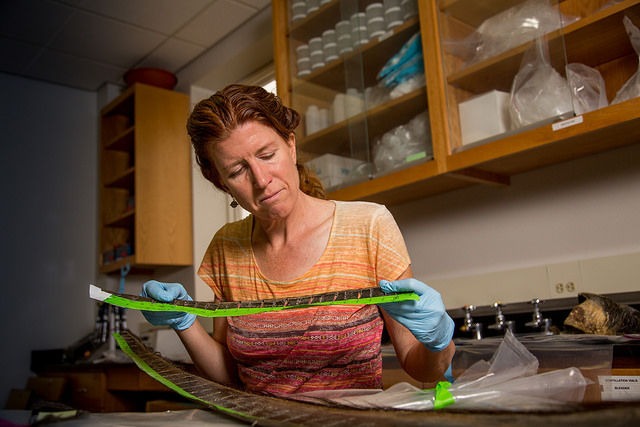Although North Atlantic right whales, humpback whales and bowhead whales–all species of baleen whales–are some of the largest animals on Earth, they are also among the most critically endangered. These whales were hunted nearly to extinction over the last 300 years for their blubber, which was used to produce oil. Fortunately, these species are repopulating, but because they reproduce slowly, their numbers are more vulnerable to dangers such as collisions with ships and entanglement in fishing lines.
By understanding more about the female whales’ breeding habits–including how often they breed, the length of their gestation and where they give birth–scientists can work with environmental groups and government agencies to find ways to better protect them. But because of their size and speed, and the vast expanse of ocean that is their habitat, they’re extremely difficult animals for scientists to study.
Methods used to study other animals, such as obtaining blood samples, are literally impossible when it comes to these giant marine mammals. Even the most basic physiological information about these species remains unknown or uncertain among the scientific community.
That’s why Kathleen Hunt, wildlife endocrinologist and research professor in Northern Arizona University’s Department of Biological Sciences, has pioneered some novel ways to analyze the hormone levels present in unusual sample types. According to Hunt, who joined NAU in 2016, hormones produced by the endocrine glands–including the pituitary gland, the thyroid gland, the ovaries and testes–can reveal important clues about an animal such as its levels of stress and reproductive health.
Hunt’s work includes developing a method for collecting and testing individual whale respiratory vapor droplet samples, or “whale blow,” using hand-held poles outfitted with polypropylene tubes covered with mesh fabric. But Hunt believes the most promising area of study has been developing new ways to test the endocrinological information stored in whale baleen–the hairy, fringed plates that hang down from their upper jaws and filter zooplankton and other small crustaceans from the water. Hunt has found that baleen, which has not been previously used to study whale physiology, stores a wide range of hormonal data that can help chart a female whale’s reproductive history.
The baleen on a North Atlantic right whale can grow to more than eight feet long and show more than ten years’ worth of data. Hunt can analyze pulverized baleen for the presence of hormones such as cortisol and progesterone, which reveal startlingly clear information about the whale’s levels of stress and reproductive physiology. For example, she can determine how often a female whale has been pregnant from the progesterone levels present at different growth points in the baleen–data that is critical to advancing understanding of how often the whales reproduce.
Hunt’s research, which has been published in several scientific journals, including Conservation Physiology, as well as in mainstream publications such as the New York Times and NewsWorks, is gaining attention from the international marine biology community because it’s giving scientists more ways to study the animals and collect meaningful data about them.
Most of Hunt’s baleen specimens were collected from stranded whale carcasses. She works in collaboration with the U.S. Marine Mammal Stranding Network to collect and study these specimens and hopes to use them to illuminate the stressful health effects of chronic entanglement in fishing gear, a serious issue for whales today and a common cause of death. She has recently begun working with several natural history museums as well, many of which have collections of whale baleen that date back centuries.
Even NAU has some baleen—the Mammalogy laboratory has a large piece of bowhead whale baleen that has been in Flagstaff since at least 1991. Hunt hopes to be able to determine this whale’s sex and reproductive history from the detailed study of this single baleen piece. She believes this will be the first attempt to study reproductive cycles from a several-decades-old specimen of whale baleen.
A zoologist by training, Hunt has studied a variety of animals all over the world, including tundra-nesting birds, sea turtles, African and Asian elephants, bear, elk and sea lions. Hunt is currently conducting field projects on gray whales off the Oregon coast and humpback whales in the Gulf of Maine. She has grant proposals pending for two other whale projects, one to study southern right whale calves who are being attacked by kelp gulls off the coast of Argentina, and a second on reproductive cycles in male whales.
Hunt also plans to study tortoises, antelope and birds while at NAU. She has two publications out on the baleen hormone technique, two more in progress and she will be presenting her most recent data at the annual meeting of the Society for Integrative and Comparative Biology in New Orleans in January 2017.



